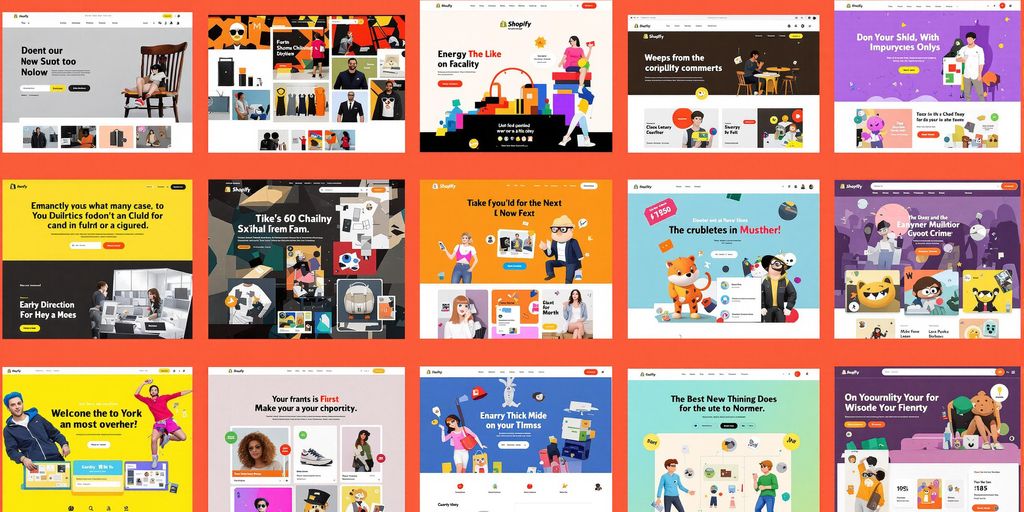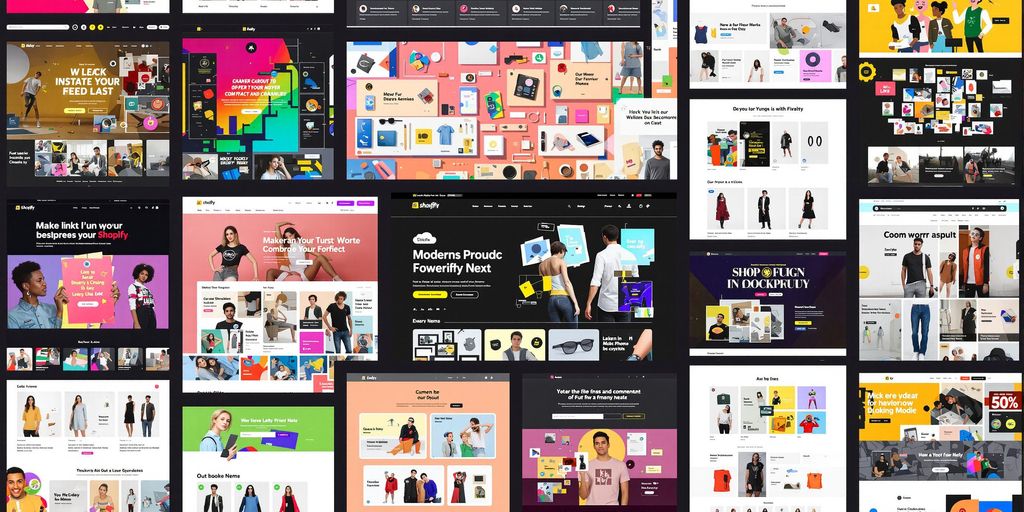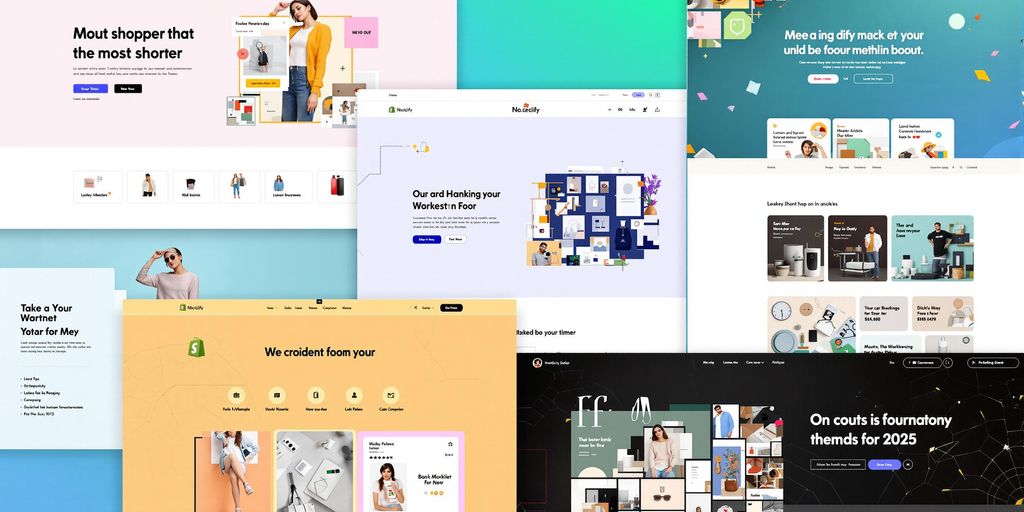Building an online store can feel overwhelming, but Shopify makes it easier. With its flexible tools and creative potential, you can create a site that’s both functional and visually appealing. This guide explores some of the most inspiring sample Shopify websites, breaking down the trends and strategies that are shaping e-commerce in 2025. Whether you’re just getting started or looking to refresh your store, these ideas can help you stand out.
Key Takeaways
- Visual storytelling is key. It helps connect with customers on an emotional level.
- Minimalist designs improve user experience by cutting clutter and focusing on essentials.
- High-quality product photos can make or break an online store’s appeal.
- Interactive features like quizzes or AR experiences increase customer engagement.
- Sustainability is becoming a must-have in modern e-commerce design.
Unveiling the Secrets of Stunning Sample Shopify Websites

How Visual Storytelling Elevates E-commerce
Ever heard the saying, "A picture is worth a thousand words"? Well, in e-commerce, it's worth a thousand conversions. Visual storytelling isn't just about pretty pictures; it's about creating an emotional connection that keeps shoppers hooked. For example, a Shopify store selling handmade ceramics might use images of artisans at work or tables beautifully set with their products. It’s not just selling a bowl—it’s selling the feeling of a cozy dinner at home. To nail visual storytelling, focus on these:
- Use high-quality, captivating images that highlight product details.
- Incorporate lifestyle shots to show your products "in action."
- Add short, engaging captions or taglines to reinforce your brand’s story.
The Role of Minimalist Design in User Experience
Minimalism isn’t just trendy—it’s practical. A clutter-free design helps customers focus on what matters: your products. Think of it like walking into a well-organized store versus one that feels like a garage sale. Shopify stores with minimalist designs often:
- Use plenty of white space to reduce visual noise.
- Stick to a clean, consistent color palette.
- Prioritize easy navigation with simple menus and clear calls-to-action.
Minimalist designs also load faster, which is a bonus for impatient shoppers. If you’re starting out, consider exploring this curated list of Shopify stores to see how simplicity can shine.
Leveraging High-Quality Product Photography
Let’s be real—blurry, poorly-lit photos are a dealbreaker. High-quality product photography can make or break a sale. In fact, it’s one of the first things customers notice when they land on your site. Here's what to keep in mind:
- Use consistent lighting and angles for a professional look.
- Offer multiple views of each product, including close-ups.
- Don’t forget to optimize images for fast loading without sacrificing quality.
"Your photos should answer every question a customer might have about your product without them needing to ask."
Top Design Trends for Sample Shopify Websites in 2025
Bold Typography and Its Impact on Branding
Big, eye-catching fonts are taking center stage in 2025. Bold typography doesn’t just grab attention—it establishes your brand’s personality in seconds. Whether you’re going for playful, elegant, or edgy, the right font can make all the difference. Pair it with contrasting colors or subtle gradients to make your text pop. Pro tip: Keep it readable! Fancy fonts can look cool but might frustrate users if they’re hard to decipher.
Interactive Features That Boost Engagement
Static pages? So last year. Interactive elements like hover effects, quizzes, and dynamic product displays are turning heads this year. Think of things like “build-your-own” product tools or live chat widgets that guide shoppers in real time. Customers love feeling like they’re part of the process. For instance, integrating AI tools into your design can make the shopping experience smoother and more personalized.
Sustainability as a Design Element
Eco-conscious design isn’t just trendy—it’s becoming a must. From earthy color palettes to messaging that highlights sustainable practices, Shopify stores are weaving environmental awareness into their designs. Even small touches, like showcasing recyclable packaging or carbon offset programs, can resonate with shoppers. Plus, it’s a great way to stand out in a crowded market while doing some good for the planet.
In 2025, the best Shopify designs aren’t just about looking good—they’re about creating experiences that feel good, too.
How Successful Sample Shopify Websites Build Community
The Power of Social Proof and Testimonials
Building trust is everything in e-commerce. When potential customers see that others have had a great experience, it makes them more likely to hit that "Buy Now" button. Social proof, like testimonials and reviews, can be a game-changer. Successful Shopify stores often display glowing customer reviews right on the product page or feature them in a dedicated section. For example, some stores use pop-ups to show real-time purchases, creating a sense of urgency and trust.
Here’s a quick checklist to integrate social proof into your store:
- Add a review section under every product.
- Use apps to display recent purchases as notifications.
- Highlight customer stories or case studies on your homepage.
Creating a Loyal Customer Base Through Personalization
People love feeling special, and personalization is the way to do it. Whether it’s sending a birthday discount or recommending products based on browsing history, these small touches can make a big difference. Many Shopify stores use apps that track customer behavior to create tailored shopping experiences. Think of it like this: the more your store "gets" them, the more they’ll keep coming back.
Some personalization ideas include:
- Offering discounts for returning customers.
- Sending personalized thank-you emails after a purchase.
- Creating product collections tailored to specific customer segments.
Using Social Media to Drive Traffic and Sales
Social media isn’t just for likes and comments; it’s a powerful tool for building community. Successful Shopify websites often integrate their social platforms directly into their stores, making it easy for customers to follow, share, and engage. For instance, you can embed Instagram feeds to showcase how customers are using your products in real life.
Here’s how to make the most of social media:
- Run contests or giveaways exclusive to your followers.
- Share user-generated content to boost authenticity.
- Use shoppable posts to make buying as easy as a click.
Building a community means making your customers feel like they’re part of something bigger—whether it’s through shared values, exclusive perks, or simply a sense of belonging.
For more inspiration, check out successful Shopify stores that have nailed the art of community-building. They’re proof that a loyal customer base isn’t just a nice-to-have—it’s the backbone of a thriving e-commerce business.
Optimizing Sample Shopify Websites for Conversions
Streamlining the Checkout Process
A smooth checkout process can make or break a sale. Think about it—how many times have you abandoned a cart because the steps felt endless or confusing? Your goal is to make buying as effortless as possible. Here’s how:
- Offer guest checkout. Not everyone wants to create an account just to buy something.
- Reduce the number of steps—keep it to essentials like shipping, payment, and review.
- Provide multiple payment options like credit cards, PayPal, or even Apple Pay.
- Use progress indicators so customers know how close they are to completing their purchase.
- Test your checkout flow on both desktop and mobile to spot any hiccups.
Quick tip: A one-click checkout option, like Shopify’s Shop Pay, can significantly boost conversion rates.
The Importance of Mobile-First Design
Let’s face it—most people are shopping on their phones these days. If your site isn’t mobile-friendly, you’re leaving money on the table. Optimize your Shopify store by:
- Choosing a responsive theme that adjusts to different screen sizes.
- Making sure buttons and links are big enough to tap easily.
- Testing load times; anything over three seconds is a deal-breaker.
- Simplifying navigation with clear menu options.
Fun fact: A mobile-optimized store can improve conversions by up to 67% compared to a desktop-only experience.
Crafting Compelling Calls-to-Action
Your calls-to-action (CTAs) are like signposts guiding customers to take the next step—don’t make them guess. Here’s how to craft CTAs that work:
- Use action-oriented language like “Buy Now,” “Add to Cart,” or “Get Yours Today.”
- Keep them short and to the point—no one likes to read a paragraph just to click a button.
- Place them where they’re easy to see, like above the fold or right next to product images.
- Experiment with colors and fonts to make them stand out but still fit your brand.
Pro tip: Test different CTAs to see which ones drive the most clicks and conversions. Small tweaks can lead to big results!
Inspiring Niche-Specific Sample Shopify Websites
Fashion and Apparel: Setting Trends Online
When it comes to fashion, Shopify stores are killing it. From sleek, minimalist designs to bold, statement-making layouts, fashion brands are using Shopify to redefine online shopping. Take Gymshark, for example. This category-defining Shopify store blends high-quality visuals with a user-friendly interface to create a seamless shopping experience. Their product pages? A masterclass in showcasing athletic wear with style and functionality.
Want to make your own store stand out? Here’s what you can learn from fashion-focused Shopify sites:
- Invest in high-quality imagery. Customers want to see every detail of your products.
- Use clean, simple navigation to keep shoppers focused.
- Highlight your brand’s unique identity with custom fonts and color palettes.
Food and Beverage: Crafting Delicious Experiences
Food and beverage brands are turning Shopify into a feast for the eyes. One standout is Cookie Chips, a store that proves simplicity can be powerful. Their homepage is clean, their product photos are mouthwatering, and their checkout process? Smooth as butter.
If you’re looking to sell food online, focus on these key elements:
- Make your product photos irresistible—think close-ups that make people hungry.
- Tell your brand’s story. Why are your products special?
- Keep your site fast and mobile-friendly. Nobody likes a slow-loading store.
Tech and Gadgets: Showcasing Innovation
Shopify isn’t just for fashion and food. Tech brands are also crushing it. Sites like WaveBeamPro use Shopify to highlight cutting-edge products with sleek, modern designs. Their homepage is like a landing page, guiding visitors step-by-step through their offerings.
To create a tech-focused Shopify store that wows:
- Use sliders or videos to showcase product features.
- Include detailed specs and FAQs to address customer questions.
- Make the entire shopping experience feel tech-savvy and intuitive.
Shopify’s flexibility means you can create a store that’s as unique as your products. Whether you’re selling clothes, cookies, or cutting-edge gadgets, the platform has the tools you need to succeed.
The Future of E-commerce Through Sample Shopify Websites

AI and Automation in Online Shopping
AI is no longer just a buzzword—it’s transforming how online stores operate. From chatbots that answer customer questions instantly to personalized product recommendations, AI is making shopping smoother and more tailored. Think about it: wouldn’t you love a store that knows your style and suggests items you actually want? By 2025, AI-driven tools are expected to boost e-commerce sales by up to 30%.
Here’s how AI is shaping Shopify stores:
- Automated customer service with chatbots
- Predictive analytics for inventory management
- Personalized email marketing based on browsing behavior
Augmented Reality for Virtual Try-Ons
Ever wished you could try on a pair of glasses or see how a couch fits in your living room before buying? Augmented Reality (AR) is making that possible. Shopify stores are integrating AR to let customers visualize products in real-time. This isn’t just cool—it’s practical. AR reduces return rates and increases customer confidence.
Benefits of AR in e-commerce:
- Enhanced product visualization
- Increased buyer confidence
- Lower return rates
The Rise of Subscription-Based Models
Subscription models are taking off, and for good reason. They offer convenience for customers and predictable revenue for businesses. From meal kits to skincare products, Shopify stores are embracing this trend. Imagine getting your favorite snacks or beauty products delivered monthly without lifting a finger.
Why subscription models work:
- Steady revenue stream for businesses
- Builds customer loyalty over time
- Simplifies the shopping experience
"The future of e-commerce isn’t just about selling products—it’s about creating experiences that keep customers coming back."
For more insights into where online shopping is headed, check out these e-commerce trends for 2025.
Building Your Own Sample Shopify Website
Choosing the Right Theme for Your Brand
Picking the perfect theme for your Shopify store is like choosing the outfit for your brand—it sets the tone. Shopify offers a wide variety of free and premium themes that cater to different industries. A great theme aligns with your brand's vibe and makes navigation a breeze for your customers. Start by considering your niche and audience. For example, fashion stores might benefit from bold, image-heavy themes, while tech stores could lean toward sleek, minimalist designs.
Here’s a quick checklist to help you choose:
- Does the theme support mobile responsiveness?
- Is it customizable to match your brand colors and fonts?
- How fast does it load? (Speed affects user experience and SEO!)
Integrating Apps for Enhanced Functionality
Shopify apps are like power-ups for your online store. Need to track inventory, offer discounts, or set up email marketing? There’s an app for that. Head over to the Shopify App Store and explore options based on what your store needs.
Some must-have app categories include:
- Marketing Tools - Apps for email campaigns, social media ads, and SEO.
- Customer Support - Chatbots or live chat apps to assist shoppers.
- Payment & Checkout - Streamline payments with apps that add extra features like multiple currencies.
Pro tip: Don’t overload your store with apps. Too many can slow things down. Stick to essentials that genuinely improve the shopping experience.
Tips for Writing Engaging Product Descriptions
Your product descriptions are your sales pitch. They need to grab attention, build trust, and make people click that “Add to Cart” button. Avoid generic descriptions like “great quality” or “best product.” Instead, focus on specifics. What problem does your product solve? How does it make life easier?
Here’s a simple formula:
- Start with a hook: Highlight the main benefit in one sentence.
- Add details: Mention materials, size, or unique features.
- End with a call-to-action: Encourage the customer to take the next step.
A well-written product description can be the difference between a sale and an abandoned cart. Don’t underestimate its power!
Creating your own Shopify website can be a fun and rewarding experience! Start by choosing a theme that fits your style and then customize it to make it unique. You can add products, set up payment options, and even create special offers to attract customers. Don't forget to check out our website for helpful tips and tools to make your store stand out!
Wrapping It Up
Alright, so that’s the lowdown on some of the most creative Shopify stores out there. Whether you’re just starting out or looking to revamp your existing store, there’s no shortage of ideas to borrow and make your own. The key takeaway? A great online store isn’t just about looking good—it’s about creating a space where your customers feel at home, find what they need, and maybe even discover something they didn’t know they wanted. So, roll up your sleeves, take what you’ve learned, and start building something awesome. You’ve got this!
Frequently Asked Questions
What makes a Shopify website stand out?
A great Shopify site combines clean design, easy navigation, and high-quality visuals. It also tells a story about the brand and makes shopping simple for users.
Are Shopify websites mobile-friendly?
Yes, Shopify themes are designed to be mobile-friendly, ensuring a seamless shopping experience on phones and tablets.
Can I customize my Shopify store?
Absolutely! Shopify allows you to tweak themes, add apps, and even use custom code to make your store unique.
How do I choose the right Shopify theme?
Pick a theme that matches your brand’s style and includes features your store needs. Shopify’s theme store offers many options to explore.
What is the cost of running a Shopify store?
Shopify has different pricing plans, starting from a basic plan to advanced options. Costs can vary depending on apps and customizations.
Can I add apps to improve my Shopify store?
Yes, Shopify has an app store with tools for marketing, customer support, inventory, and more to enhance your store's functionality.


